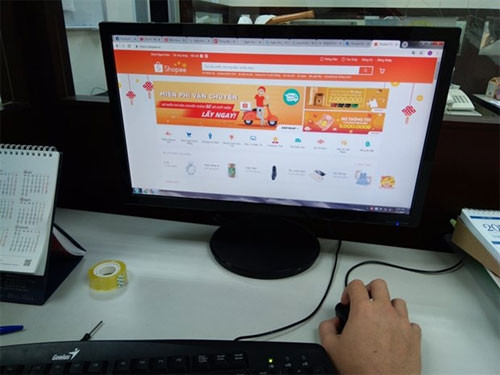 |
A customer browses products on shopee.vn. Vietnam’s e-commerce
market is forecast to climb 20 per cent in the last quarter of this year to reach
12 billion USD by year end (Photo: VNA)
This is the forecast by the Ministry of Industry and Trade (MoIT) in a recent
report on Vietnam’s e-commerce market against the backdrop of the COVID-19
pandemic.
In the early stages of the pandemic (from February to April), 57 percent of
surveyed e-commerce-related businesses reported their revenue growth was below
30 percent compared to the same period of 2019 with some even seeing negative
growth, the report said.
However, 24 percent of businesses saw revenue increasing more than 51 percent.
E-commerce revenue in the first six months declined 6 percent year-on-year
despite the number of transactions increasing by 25 percent. Most transactions
at that time were of low value.
Under circumstances when the disease is kept at bay, the ministry forecasts
e-commerce revenue to rise 20 percent in the last three months to reach 12
billion USD.
If the pandemic worsens, impacting production and consumption, supply and
operations of transport and catering services, growth could reach only 13
percent with estimated market value of 11 billion USD.
Vietnam is one of the most dynamic e-commerce markets in the world with an
average growth rate of more than 30 percent per year in the last five years.
In May, the Government approved the national e-commerce development master plan
for 2021-2025, targeting annual industry growth of 25 percent with more than
half of the population shopping online and average spending of about 600 USD per
person per year by 2025.
The market size is expected to reach 35 billion USD by 2025, ranking third in
Southeast Asia.
Business-to-consumer (B2C) sales will rise 25 percent per year, accounting for
10 percent of total retail sales of goods and services. Cashless payments in
e-commerce would make up 50 percent and about 70 percent of transactions on
e-commerce platforms would have electronic invoices.
At the same time, the gap in e-commerce development between Hanoi and HCM City
and other localities is also expected to narrow.
To achieve this goal, the MoIT is building mechanisms and policies to promote
digital transformation and enhance the capacity to manage and organise
e-commerce activities and boost consumer confidence.
In the first nine months of this year, the authority handled more than 2,200
cases of e-commerce violations and other acts of taking advantage of e-commerce
to trade in smuggled goods, goods of unknown origin, goods infringing
intellectual property rights and counterfeit goods with fines worth more than 16
billion VND (690,000 USD).
A number of cases attracted attention including fake products sold by Ansan
Cosmetics chains and through the Kagawa.vn platform, as well as food safety
scandal of Minhchay.com.
In addition, since the beginning of the year, the ministry has asked e-commerce
platforms to review and remove nearly 223,600 shops and more than one million
products, handling more than 30,000 violating shops with nearly 48,000 products.
Source: VNA




















.jpg)




.jpeg)

.jpeg)


.jpeg)


